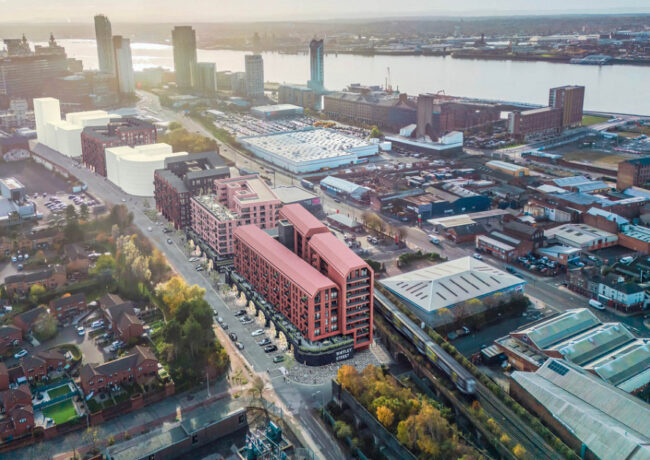Enterprise Zones | Mersey Waters
Mersey Waters is the most ambitious and large-scale of the North West’s Enterprise Zones. Have the advantages conferred by the special status helped this mammoth project, asks Neil Tague.
Way back in 2006, Peel first announced its plans for two multi-billion pound regeneration projects on either side of the Mersey. It was always one for the long-haul, with Liverpool’s World Heritage site to contend with, along with the complexities of dealing with massive remediation projects – the Wirral side alone comprises 500 acres of semi-derelict dockland.
Because the projects have been talked about for so long, it’s no surprise there’s some cynicism over delivery, and the travails of the £175m Wirral International Trade Centre project have done nobody any favours. But judge Wirral Waters by work on the ground since planning permission in May 2012, and there’s both a clear direction of travel and job creation.
Richard Mawdsley, director of development at Peel, said: “Some of the Enterprise Zones were more mature, whereas we were starting with a blank canvas. Since 2012, we’ve been addressing the hurdles to delivery – remediation, infrastructure, and then the viability issue.” Thirty-five acres have been remediated, with another 30 in hand, while energy infrastructure has been put in. Some 1,500 trees have been planted by a Peel and Mersey Forest joint venture.
Development so far has centred on Tower Road and West Float. At Tower Road, a £9m campus for Wirral Metropolitan College opened in September, funded by the FE college, Peel and the Skills Funding Academy.
An office building, home to 200 employees initially but rising to 1,200, is being delivered by Longmeadow Estates to house the Contact Company, which is funding its move with a package from Barclays, the North West Fund for Loans Plus and the Regional Growth Fund. The Maritime Knowledge Hub could be next: to be based at the listed Hydraulic Tower, it also involves Liverpool John Moores University and Mersey Maritime. Launched in September, this £15m project is aiming for Heritage Lottery Fund support.
At West Float, where Enhanced Capital Allowances are available, a Marine Energy Park will be launched “this side of Christmas,” while consent was won in February for a £35m manufacturing facility called Project Perch. “We’re working hard to make that happen,” says Mawdsley.
The biggest news came just this month, says Mawdsley, when Wirral council’s cabinet approved the Wirral Waters Investment Fund, in essence a Tax Increment Fund that will give the local authority the ability to retain 100% of all new business rates to reinvest in the zone. “It’s a game-changer,” says Mawdsley.
What of Liverpool Waters?
By Peel’s admission, work on the Liverpool side is a couple of years behind the Wirral. But there has been news this year: Peel development director Lindsey Ashworth announced at MIPIM that the first investments in Liverpool Waters were on the starting blocks: an eight-storey 100,000 sq ft office block at Princes Dock (which now has detailed consent), while Peel had agreed a deal with PRS developer Moda Living to build a 325-unit residential tower next door. Ashworth said that terms had been agreed on three of the other 88 plots within Liverpool Waters, for a hotel and more apartments.
There’s also another zone in the Liverpool mix: Liverpool City Enterprise Zone, effectively an extension of the waterfront zone around the Old Hall Street commercial area. There’s little to report to date – indeed one office building will become a hotel – but its presence signifies the preparedness of the government to embellish EZ status on further locations, as the Comprehensive Spending Review today will underline.
Verdict
Enterprise Zone status, suited to a leafy science campus like Daresbury, never really looked likely to make a monster scheme like Mersey Waters come alive. In policy terms, especially considering the timeframes by which EZs were supposed to deliver thousands of jobs, it’s been a failure. That much is evident in the late arrival now of a funding mechanism on the Wirral side that many in the industry have argued in favour of for years.
It’s to Peel’s credit they’ve managed to marshal collaborations, joint ventures and a patchwork quilt of funding streams to deliver what they have so far. The viability issue is being addressed. And with 310 jobs on-site, (plus 110 construction jobs) which will become 1,500 once Tower Wharf is up to speed, the job creation story is decent enough.
Even with the caveat that both zones are part of a city region-wide story that’s been focused on other priorities – offshore energy and the super-port, namely – the Liverpool zone to date can’t really boast of an enterprise story. There’s to be an office block in an already established office location, and a few hundred waterside flats – hardly unique, and hardly a long-term driver of jobs. Something big needs to happen.
Continue reading Neil Tague’s analysis of North West Enterprise Zones




